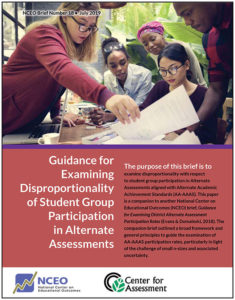 The National Center on Educational Outcomes (NCEO) and the National Center for the Improvement of Educational Assessment (NCIEA) jointly published a Brief titled Guidance for Examining Disproportionality of Student Group Participation in Alternate Assessments. It is a follow-up companion to an earlier Brief titled Guidance on Examining District Alternate Assessment Participation Rates. The Every Student Succeeds Act (ESSA) places a 1% cap on the participation of students with the most significant cognitive disabilities in the alternate assessment aligned with alternate academic achievement standards (AA-AAAS). It also requires that states apply for a waiver prior to the testing window if the state expects it will go over the 1% participation rate. Part of the waiver application is verifying and addressing disproportionality in the participation of students with the most significant cognitive disabilities.
The National Center on Educational Outcomes (NCEO) and the National Center for the Improvement of Educational Assessment (NCIEA) jointly published a Brief titled Guidance for Examining Disproportionality of Student Group Participation in Alternate Assessments. It is a follow-up companion to an earlier Brief titled Guidance on Examining District Alternate Assessment Participation Rates. The Every Student Succeeds Act (ESSA) places a 1% cap on the participation of students with the most significant cognitive disabilities in the alternate assessment aligned with alternate academic achievement standards (AA-AAAS). It also requires that states apply for a waiver prior to the testing window if the state expects it will go over the 1% participation rate. Part of the waiver application is verifying and addressing disproportionality in the participation of students with the most significant cognitive disabilities.
Disproportionality in the percentage of students in any ESSA subgroup is to be examined and addressed for each district expected to test more than 1.0% of its assessed students in the state’s AA-AAAS. The student groups are: seven racial and ethnic groups (White, Black or African American, Hispanic, Native American or Alaska Native, Asian, Pacific Islander, and Multiracial), socioeconomic status, and English learners. The Brief was developed to assist states because ESSA does not explicitly define ”disproportionality” or provide guidance on the methodology to use for analyses.
The Brief defines disproportionality in the following way:
Disproportionality exists when there are atypical differences in the proportions of participants from a student group who take the alternate assessment in comparison to the general assessment.
The overall framework recommended in the Brief includes four guiding principles:
- A comprehensive solution cannot be purely empirical due to small n-sizes.
- It is important to detect atypical or “exceptional” values.
- Apply methods to address uncertainty.
- The culminating decision and subsequent actions based on the evidence is (a) a matter of degree, and (b) related to unique context and circumstances.
The Brief highlights three steps (including specific approaches) to take to address the following basic questions.
- Is the proportion of students who participate in the AA-AAAS consistent with the proportion expected to participate?
- Do the differences between participation and expectation vary across student group membership?
- Are the differences sufficiently pronounced to suggest the finding is meaningful?
Details on producing confidence intervals suggested for determining whether a difference is meaningful are available in a video module titled Guidance for Examining Participation Rates and Disproportionality.
